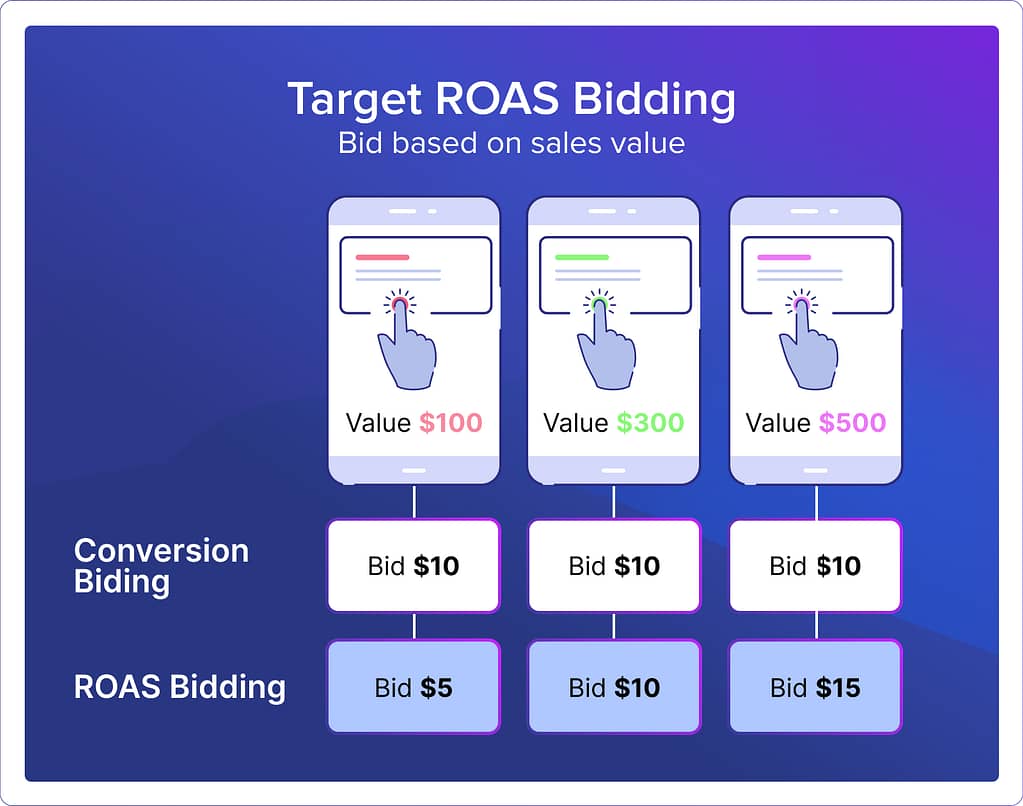What is Target ROAS?
Target ROAS (tROAS) is a bidding strategy in Google Ads designed for businesses seeking to maximize the return on their advertising spend.
It is one of Google’s Smart Bidding strategies that uses machine learning and AI to predict future conversions and adjust your bids in real-time. It is particularly useful when you have specific return on investment (ROI) goals for your campaigns.
Here’s how it works: First, you set a desired return on ad spend (for example: 400%). Google’s AI evaluates the potential conversion value of each search query and adjusts your bids accordingly. High-value potential conversions lead to higher bids, and lower-value prospects receive lower bids.
How to calculate Target ROAS
To calculate your ideal target ROAS, divide the desired revenue from ads by the total ad spend. For instance, if you aim for $4 in revenue for every $1 spent, your target ROAS would be 400%:
($4 in sales ÷ $1 in ad spend) x 100% = 400% target ROAS
Benefits of using Target ROAS
Efficient Ad Spend: tROAS optimizes your ad spend, ensuring your budget is allocated to the most effective campaigns that drive real downstream results based on your conversion value data.
Data-Driven Insights: by leveraging Google’s machine learning, tROAS can provide valuable insights into consumer behavior and ad performance. You can learn what products or services are most profitable, and allow you to focus your budget for increased performance.
Time-Savings: With automated bidding options like Target ROAS, you are still optimizing towards your desired outcome, but no longer need to spend time analyzing and adjusting manually. This allows marketers to focus on strategy and improving ad creatives and messaging.
When to use Target ROAS bidding strategy
Target ROAS is a powerful bidding strategy, but knowing when to use it (and when not to) is important. Here are a few scenarios when Target ROAS is appropriate:
- Your Campaigns Have Clear Financial Goals: tROAS is perfect when there is a direct link between ad spend and revenue generation, such as in e-commerce campaigns.
- When You Have Sufficient Conversion Data: This strategy thrives on accurate data. It’s best used when your campaign has at least 15-20 conversions in the past 30 days for Google’s algorithm to make informed decisions.
- In Dynamic Market Conditions: tROAS is ideal in markets where consumer behavior and competition fluctuate regularly, as it can dynamically adjust bids for maximum efficiency.
How to set up Target ROAS campaigns in Google Ads
Here’s a quick step-by-step guide to setting up Target ROAS bidding in your campaigns.
- Select the Appropriate Campaign: First, navigate to the Google Ads campaign you wish to apply tROAS to (Note: tROAS can be used in Search, Display, Shopping, and Performance Max campaigns).
- Access Campaign Settings: In your Google Ads dashboard, go to the campaign you’ve chosen, then click on the “Settings” tab.
- Change Bid Strategy: Find “Bidding”, and look for the option “Change Bid Strategy”.
- Choose “Maximize Conversion Value”: In the list of available bid strategies, select “Maximize Conversion Value.”
- Enable ‘Set a Target Return on Ad Spend’: In “Maximize Conversion Value,” you will see an option to “Set a target return on ad spend.” Enable this option.
- Set Your Desired ROAS: Input your desired Target ROAS. This value should be based on your business goals and historical data. (Note: Target ROAS is a percentage and represents the average conversion value you expect for every dollar spent on ads. Similar to the example earlier, a target ROAS of 400% means you’re aiming for $4 in revenue for every $1 spent on ads).
- Save Your Settings: After setting your desired ROAS, click “Save” to implement these changes. Your campaign will now start using the Target ROAS bidding strategy, automatically adjusting bids to meet your specified return goals.
Mistakes to avoid with Target ROAS
Setting Unrealistic Targets: Overly ambitious ROAS targets can hinder campaign performance. You should use historical performance to guide you, and set ROAS targets that move towards your ideal target ROAS without being too far from historical performance.
Neglecting Conversion Tracking: Inaccurate tracking or incorrect conversion values can negatively affect Google’s ability to hit your target ROAS.
Not Enough Performance Data: Failing to adjust ROAS targets in response to market changes can render campaigns ineffective.
What is the difference between Target CPA and Target ROAS?
Target CPA is focused on the cost of acquiring a single conversion, regardless of the conversion’s value. In contrast, Target ROAS emphasizes the revenue generated per dollar spent on ads.
Target ROAS is a value-based strategy vs. a conversion-based strategy like Target CPA. Instead of optimizing for the most conversions possible, you are now prioritizing the most valuable customers. Because this is a shift from conversion volume to conversion quality/value, you may see higher total conversion value, but lower conversion volume than Target CPA.
Deciding between these two strategies depends on your campaign objectives and how you measure success. If your goal is to acquire new customers or leads at a consistent cost, tCPA is the way to go. However, if your focus is on maximizing revenue or ensuring a specific financial return from your ad spend, tROAS will be more effective.
Frequently asked questions
How many conversions do I need to use Target ROAS?
For most campaign types, you’ll need at least 15 conversions in the past 30 days. There are some specifics, depending on your campaign type:
- Display campaigns need least 15 conversions (with valid conversion values) in the past 30 days across all of your campaigns combined
- Demand Gen campaigns (formerly Discovery Ads) need a minimum of 100 conversions in the past 30 days, and 10 of these conversions must be in the past 7 days.
- App campaigns require at least 10 conversions every day, or 300 conversions in 30 days.
- Video Action campaigns should have a minimum of 30 conversions in the past 30 days.
How often should I adjust my target ROAS?
As with most smart bidding, there is a learning phase where Google’s bidding systems are working to hit your targets. While it is important to review your performance regularly, you should not make adjustments more frequently than every 1-2 weeks to allow for the system to optimize towards your targets.
Related glossary terms:






